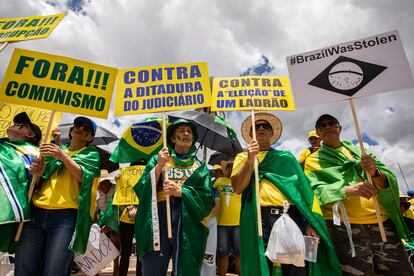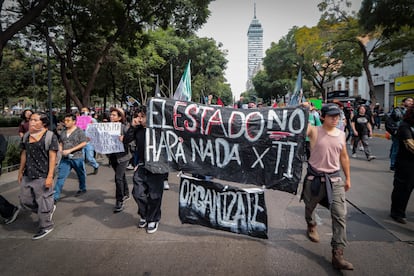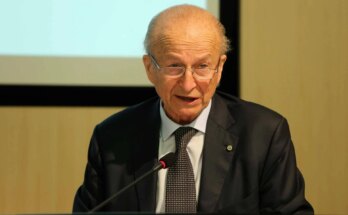Brazil has been the testing ground for the new digital weapons of the Latin American far right. And the success was so resounding that a provocative and virtually unknown lawmaker named Jair Messias Bolsonaro became president in January 2019.
Four years later, the spotlight is on Javier Milei: a vociferous, curly-haired Argentine economist. The far-right phenomenon is growing in Chile, led by Johannes Kaiser, until recently a presidential candidate. And now the network is trying to gain a foothold in Mexico, where it is still looking for a figurehead.
Regardless of the country, the strategy is always the same: armies of digital mercenaries spread their rhetoric outside of traditional media. On One of these was held on Saturday, November 15 in Mexico City, to protest the administration of President Claudia Sheinbaum.
In Mexico, the far right had little popular support and no institutional presence. There are only two far-right groups that aspire to become political parties before the 2027 midterm elections. One of them is led by actor Eduardo Verástegui, who once had a good relationship with the Argentine president. Their alliance was short-lived, however: an unexpected exchange of insults on X last October ended the partnership. This also led to the cancellation of the Conservative Political Action Conference (CPAC) that was supposed to be held in Mexico this month.
Lacking electoral representation, the Mexican conservative movement’s presence is currently concentrated on social media. It was there that the controversial rally call – allegedly attributed to members of “Generation Z” – emerged. Although presented as a spontaneous movement similar to those that shook Nepal, Madagascar or Morocco, an investigation by Infodemia – a Mexican government unit dedicated to analyzing disinformation – claims that it was, in fact, a “coordinated digital strategy”. The report names influencers, opposition figures and accounts linked to the Atlas Network – an ultranationalist organization founded in the early 1980s, with a presence in more than 100 countries – as being behind the campaign. According to the report, more than 90 million Mexican pesos (about $5 million) have been spent promoting the march over the past month and a half.
The official investigation also indirectly involves Ricardo Salinas Pliego, owner of the TV Azteca network. Two weeks ago, Mexico’s Supreme Court ruled against him after years of litigation, ordering the businessman to pay 50 billion pesos (nearly $3 billion) in back taxes. This setback intensified the debate over Salinas Pliego’s alleged role in digital campaigns criticizing Claudia Sheinbaum when she headed the Mexico City government (2018-2023).
Infodemia traces the origins of the most recent digital campaign to early October, when Azteca Noticias published a report on Generation Z protests taking place beyond Mexico. Dozens of social media accounts then emerged, with names like “generacionz_mx” or “somosgeneracionzmx,” all calling for a march to take place in the Mexican capital on November 15. Nearly 200 accounts promoted the protest on TikTok, including 50 created or reactivated during that time. On Facebook, more than 350 groups have discussed the issue, many of them run from abroad.
The tone of the messages changed abruptly in the first half of October. Then, following the assassination of a mayor in the state of Michoacán on November 1, the narrative changed: There were calls for the president to be removed from office, as well as accusations of the federal government’s failure to address the violence. Infodemia claims that this change in tone was orchestrated.
The report reports the presence of Atlas Network bots and mentions an Argentine citizen: Fernando Cerimedo. Until a few months ago he was responsible for Milei’s digital campaign.
Cerimedo is a well-known figure in the Southern Cone of South America. His name has appeared more than 60 times in the police investigation into the coup plot against Luiz Inácio Lula da Silva, which led to Jair Bolsonaro’s conviction last September. Cerimedo was accused of having spread an alleged “investigation” that questioned the reliability of the Brazilian electoral system, in order to discredit the victory of the leader of the Workers’ Party (PT). Ultimately, in February 2025, police cleared Cerimedo of involvement in the coup plot, although they noted that the Argentine had spread “unfounded content.”
Bolsonaro’s movement germinated on social media. There, far from the radar of Brazil’s mainstream media, the anti-establishment and anti-corruption rhetoric of a lawmaker – known only for his provocations – seduced millions of citizens in 2018. That year, a majority of Brazilians voted for the retired army captain, united by a weariness of traditional politics and a visceral hatred of the Workers’ Party. Lula – who had previously been president from 2003 to 2011 – was out of action, jailed on corruption charges that were later dropped.
The patriarch of the Bolsonaro clan was so aware of the crucial role of the Internet (especially WhatsApp messages) in his electoral victory that, on the day of his inauguration, his son Carlos – a city councilor and his father’s digital campaign strategist – accompanied his father in the Rolls-Royce that took the far-right leader to the presidential palace in Brasilia. After the surprise victory, they managed to build a far-right political movement on Facebook, Twitter (now X), YouTube and TikTok. This decimated parts of the traditional right and co-opted most of the country’s remaining conservatives.
The then president launched a weekly Facebook page in which, in the style of Venezuelan President Hugo Chávez’s television program, Hello President (1999-2012) – called on ministers to boast about the government’s achievements. The digital militias created by Carlos Bolsonaro when his father came to power functioned like a well-oiled machine. He has assembled a network with influential politicians and allied media outlets, in order to launch synchronized attacks against rivals, silence critics or put certain issues at the center of the national debate. Bolsonaro’s digital ecosystem has even spawned its own version of Netflix: this streaming service has produced films and documentaries focusing on the key themes of the right-wing movement: God, homeland and family.

The digital world inhabited by Bolsonaro’s most radical supporters – people fueled by distorted or false information – was a breeding ground for thousands of people who falsely believed that Bolsonaro had been robbed of the 2022 presidential election. They were convinced to camp outside military barracks for two months, demanding soldiers intervene. They subsequently launched an all-out assault on the institutional heart of the republic, in Brasilia. Hundreds of Bolsonaro supporters are now serving long sentences for participating in an attempted coup, while Bolsonaro awaits the terms of his 27-year prison sentence.
La Derecha Diario, a far-right ram
Before Bolsonaro fell from grace, Cerimedo had already returned to Buenos Aires, where – since 2012 – he directed La Derecha Diario (“The Daily Right”). He is one of the main digital disseminators of far-right ideas in Latin America, as well as a great propagator of disinformation against everything that smacks of progressivism. Cerimedo’s website isn’t known for having high traffic, but his account on X has over half a million loyal followers who amplify his message.
In June 2021, Cerimedo brought Javier Negre on board. The Spanish agitator had sensed Milei’s bright political future from Madrid (Milei was running for a seat in Congress at the time). Negre decided to reinvent himself overseas, after a failed stint as a journalist in his home country. The new company was called Madero Media Group SRL and started with 100,000 Argentine pesos, or just over $1,000 at the exchange rate at the time.
After years of frenetic activity, Cerimedo has now retired from La Derecha Diario (while remaining a founding member) and has broken with the Milei administration, dissatisfied with the president’s communication strategy. Today, anyone who wants to contact him personally must travel to La Paz, Bolivia, where he serves as communications advisor to newly elected President Rodrigo Paz.
Negre, however, continues his antics in Buenos Aires, after a brief experience in the United States and Israel (he went there to tell “the truth” about the war in Gaza). In Argentina, he quickly became popular for provoking other journalists at press conferences held by Milei’s former spokesman, Manuel Adorni. Those who knew him during his first months in Buenos Aires remember him as a “snake oil salesman” and a “talker” who unsuccessfully attempted to buy the Argentine media to expand his influence.
Negre’s influence eventually reached Mexico, when Salinas Pliego offered to finance a local version of La Derecha Diario. In fact, it is precisely within this digital ecosystem that the November 15 demonstration took place. Many of the Mexican influencers identified by Infodemia have no previous connection to politics: they are content creators focused on makeup, video games or music, who suddenly started posting messages in support of the march with only a few days’ notice.

While protests led by Generation Z have toppled governments in several countries, in Mexico online participation appears to lack sufficient mobilizing power. Despite this, President Claudia Sheinbaum ordered metal fences to be placed around the National Palace and several other historic buildings, while the movement’s social media accounts shared instructions on how to take them down.
Sign up to our weekly newsletter to get more English-language news coverage from EL PAÍS USA Edition



